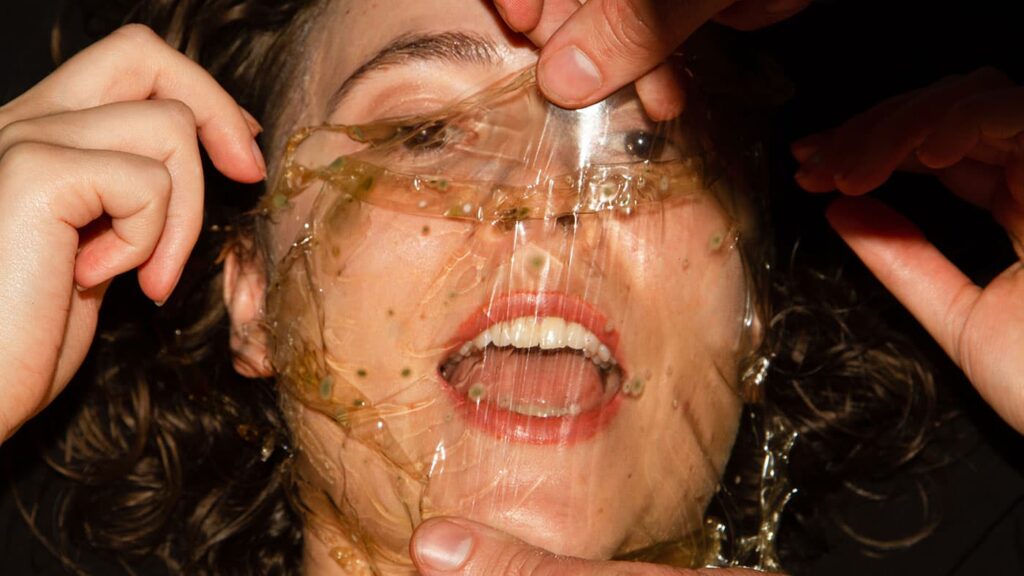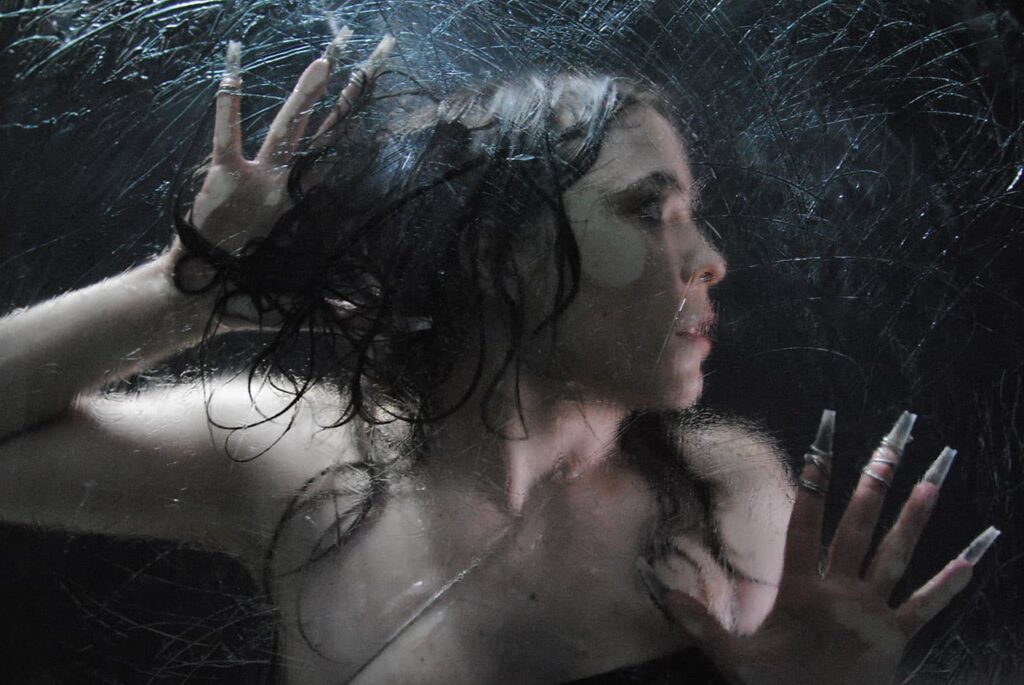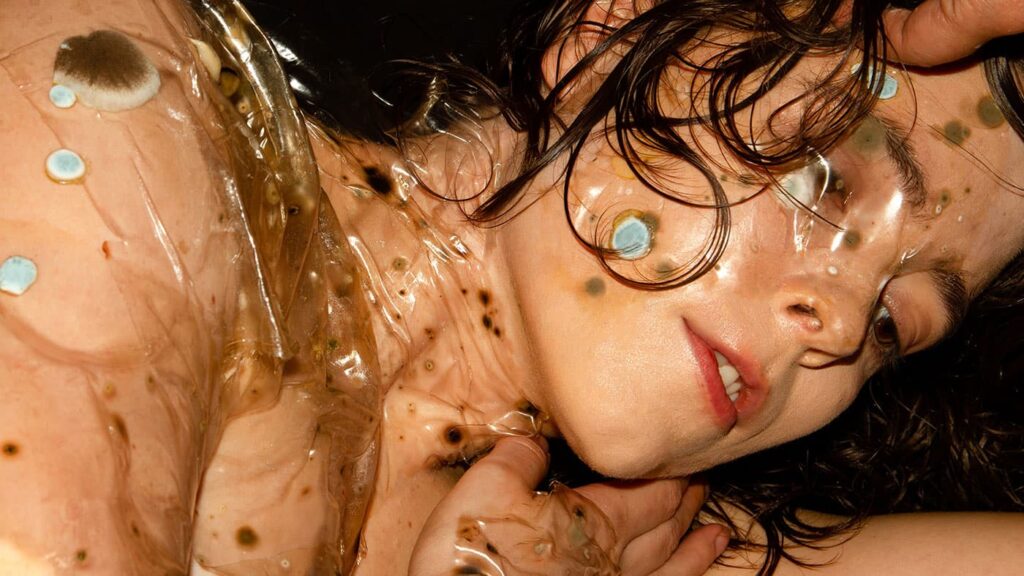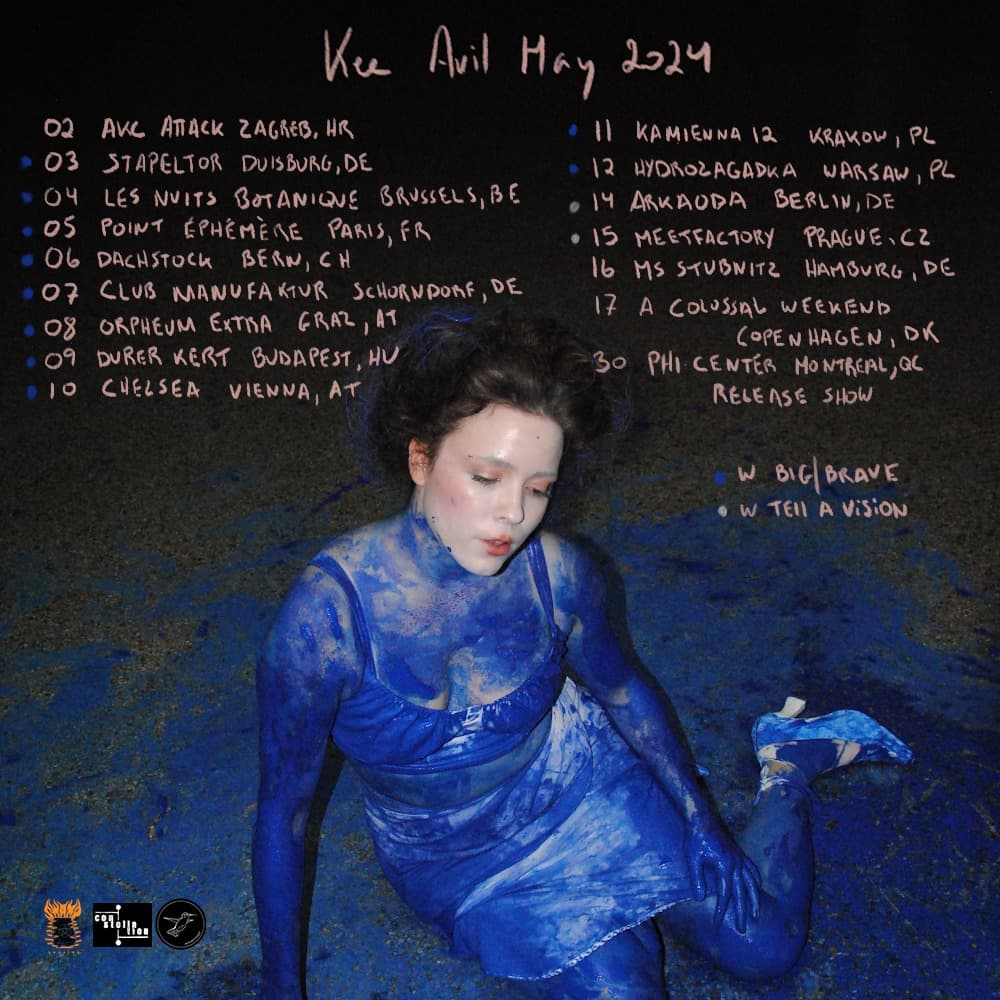
Kee Avil is a guitarist and producer based in Montreal. Her debut album ‘Crease’ has received critical acclaim from media outlets such as The Wire, The Quietus, Mojo and Foxy Digitalis. It was also nominated for a Canadian Juno Award, as well as Album of the Day and Album of the Year on Bandcamp.
Kee Avil will release her new album, Spine, in May, continuing her exploration of avant-garde glitch pop music. Her work is exploratory and intimate, stimulating both emotions and intellect. In her new release, the artist evokes a raw sound, moving away from the richly textured compositions of her previous album.
Although she describes her music as folk, it defies easy categorisation. Her songs are bold and personal, reflecting contemporary life and a blend of electronic and real-world interactions. She is an adventurous artist who fearlessly explores uncharted territory in search of her own musical language.
In May, Kee Avil will tour Europe as Big|Brave’s support. In the meantime, I invite you to read the interview.
Artur Mieczkowski

Artur Mieczkowski: I’m curious, could you tell me a bit about how you got started in music? What sparked your passion for creating music, and what were some of the first things you did as an artist?
Kee Avil: Improvised music was a big stepping stone for me as a musician. It’s how I learned to let go of all the rules and really try to create something new every time, to be inspired in the moment.
A.M.: In 2018 you released your first cassette under the name Kee Avil and in 2022 you debuted with the album Crease. What were the main differences between these materials?
K.A.: The first EP was 100% a discovery, what type of sounds do I like, what type of songs do I want to write, what’s the aesthetic for the project? Crease builds on this, it fleshes out the ideas a bit more, it’s maybe a bit less raw, more polished.
A.M.: What were your main goals and inspirations when working on Crease?
K.A.: I just want to write songs, and find new ways to do it. I think the form of a song is so flexible, it can be bent and reshaped in so many ways. But there’s something in it that always remains familiar, and I’m curious about that contrast.
A.M.: You have traveled across the US, Europe and Canada, playing at various festivals. What experiences from these travels have influenced your music?
K.A.: What I learn from performing live, I can apply to performance in a studio, or in producing. It brings a different energy to the music. It’s also always interesting to see what audiences react to during the show.
A.M.: What is your approach to improvisation in the music-making process? Do you frequently rely on spontaneous ideas when composing new pieces, or do you prefer precise planning and composition?
K.A.: Improvisation is still a huge part of how I compose – all of the songs come from improvisation, I never analyze the music or choose specific notes when writing. It’s all guided by ear and what feels right. It’d be great to try a more precise approach at some point, but I also love to rely on what the moment brings, and just sculpt from these initial ideas.
A.M.: When did you feel that you had discovered your unique sound and style in your musical career? Was there a specific moment or experience that defined this?
K.A.: I feel like I’m still figuring it out. It’s all a process to me, I don’t think I’ve quite discovered it yet.
A.M.: Your upcoming album, Spine, is set to release in May 2024. Can you share any insights on the changes and evolutions we can expect in comparison to your previous releases?
K.A.: I wanted to write songs that could be sung on guitar, like broken folk songs but with dry, sharp, driving beats. I think we managed to keep a raw aesthetic on it all, even though it’s very produced at the same time.
A.M.: You describe Spine as an album that had to be made quickly to avoid being stuck in time – it was made in just a few months. How did this short production time affect the production process and the final nature of the album? Can you tell us more about this need to make an album quickly and how it influenced your thinking and approach to music?
K.A.: The album was written in a short period, maybe a few weeks – but it was produced and mixed over a year. The short writing period was nice because it was very condensed, and I think that captured a certain moment in time. I’m not sure how it affects the final result, but I think the album is nicely cohesive – maybe the timing of the process has something to do with that?

A.M.: Spine is not a concept album, but the themes of the passage of time, memory and decay are still present. How do these themes emerge in your music and lyrics, and how do they influence the overall message of the album?
K.A.: There’s no real message in the album, most of it is just words that I thought sounded good together. But there’s some sparks of a theme in it – as I started trying to think back as far as I could – and it’s really not that far back. seeing how it all links together to the present, and how this somehow links me to the future.
A.M.: The album aims to encourage introspection and reflection on one’s own life and past experiences. What emotions and sensations were you hoping to elicit in listeners with this album?
K.A.: Nothing specific. Once the music is released, it’s out of my hands, and I don’t really have any expectations on how people should feel.. I like connecting to people through music, I think that’s an interesting and inspiring part of it.
A.M.: I really like the aesthetics of the Spine cover, it works very well with its musical content and message. What were the inspirations and concepts behind the process?
K.A.: Thanks! For the Spine visuals, I wanted to work with mold. I think mold is so beautiful, all the different types of textures and colors, and yet it also represents decay. I love that contrast and it’s something that I also love to work with in music and visuals. How to portray something that’s ordinarily a bit revolting into a context that’s aesthetically beautiful.
A.M.: What are your primary musical inspirations and influences that shape your creative approach? Have any specific artists or musical genres had a significant impact on your music?
K.A.: This Heat was definitely a bridge between improvisation and songwriting for me, it was so great to see how songs can be patched up together from this type of chaos. Marc Ribot was a big influence for guitar playing. These days, I don’t really listen to music.
A.M.: Your music has been described as experimental and unconventional, blending various genres from post-industrial to experimental folk. Do you set any boundaries when exploring new sounds and styles, or do you allow yourself complete creative freedom?
K.A.: There are no boundaries, I just go from what I know and hope to somehow at some point end up in what I don’t know.
A.M.: Kee Avil’s music is also ‘inviting yet unsettling in its intimacy’. How to understand this paradox?
K.A.: I’m not sure, I’ve always been interested in combining the experimental within a context that remains familiar, maybe that has something to do with it?
A.M.: You also describe your music as being on the border between abstraction and reality. What are your intentions?
K.A.: I want to make music that surprises me, all the time.
A.M.: Can you tell us more about your creative process, especially the way you combine different instruments and sonic techniques to create your unique sound?
K.A.: For Spine, a lot of the songs started on guitar, often I’ll detune it, play a simple riff and then add some vocals to it, create a structure, different parts, maybe a skeleton of a beat. Then, I worked with Zachary Scholes, we re-recorded the guitar, fleshed out the beats with synths, granular synthesis, lots of foley. Lots of editing, lots of staring at a screen and placing sounds of ice cracking.

A.M.: Your image is expressive and original. How important is it for you to maintain this image in the context of your musical career? Are there any conceptual or artistic inspirations that influence the way you present yourself?
K.A.: It’s important in the sense that I enjoy working on the visuals, discovering what they’ll become, how it might help to shape the music. I have fun with it.
A.M.: What are your goals and dreams as an artist? Are there specific artists you would like to collaborate with or stages you would like to perform on in the future?
K.A.: I’d like to just be able to live off music, art in general. To just be able to do this all the time.
A.M.: In May, you will also embark on a European tour with BIG|BRAVE and play, among other things, two concerts in Poland. What are your expectations and hopes for this tour?
K.A.: I’m excited to share this new music live, to meet new people, and come back hopefully inspired and write more music.
A.M.: Are you also involved in other musical projects?
K.A.: None that I can think of at the moment.
A.M.: What are your future plans for Kee Avil?
K.A.: Release a new record. Decay slowly.
A.M.: Thank you for the interview and good luck with your plans.
K.A.: Thank you.
